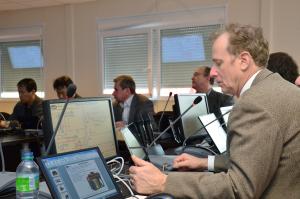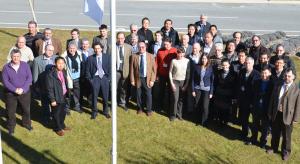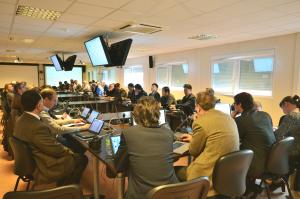Designing one-of-a-kind components
23 Feb 2012
-
Sabina Griffith
After three solid days reviewing the design of one of the most critical elements of the tokamak's power supply system—the switching networks for ITER's coil power supplies and the fast discharge units that will protect the superconducting coils in case of a quench—Chairman Charles Neumeyer from the Princeton Plasma Physics Laboratory looks tired but satisfied. More than 60 participants including experts from Russia, Korea and China had convened at the ITER Headquarters for the meeting. The largest delegation with 17 engineers had flown in from Russia to present their work in person.
"The Russian Domestic Agency's contributions that were presented at this Preliminary Design Review are critical elements of the ITER power supply system," said Neumeyer. "In particular, the high current switches used for the switching network units and fast discharge units are unique, one-of-a-kind components, available only from the Efremov Institute in St. Petersburg, which has mastered this technology over several decades of development."
All for one: the participants to Preliminary Design Review take a deep breath outside the ITER Headquarters.
The switching networks are the "lighters" that start the ITER pulses: they will trigger the pulses in the circuits of the central solenoid and poloidal field coil numbers 1 and 6 for the initiation of the plasma. The fast discharge units are used to protect the superconducting coils in case of a quench (a sudden loss of superconductivity). Large steel resistor banks are inserted in the circuits during such an event to dissipate the energy stored in the coils.
Among them, the discharge units for ITER's powerful toroidal field coils will have to extract 41 GJ of stored energy. An extra building on site with a 50 x 60 metre footprint will accommodate the resistor banks. Finally, large aluminium water-cooled DC busbars connect the power converters to the magnets feeders, for a total length of roughly 10 kilometres including the circuits for the toroidal field and the poloidal field coils, the central solenoid, and the correction coils.
The design of one of the most critical elements of ITER's power supply system—the switching networks for ITER's coil power supplies and the fast discharge units—united more than 60 engineers from around the world this week.
The Switching Network, Fast Discharge Units, DC Busbar & Instrumentation Procurement Arrangement was signed in March 2011 with the Russian Domestic Agency. "The package includes a large variety of components—most of them designed specifically for ITER. A broad R&D program has been carried out in the past years," explains Francesco Milani from the ITER Coil Power Supply Section and technical responsible officer for this package. "This meeting is therefore a key milestone in the procurement process."




